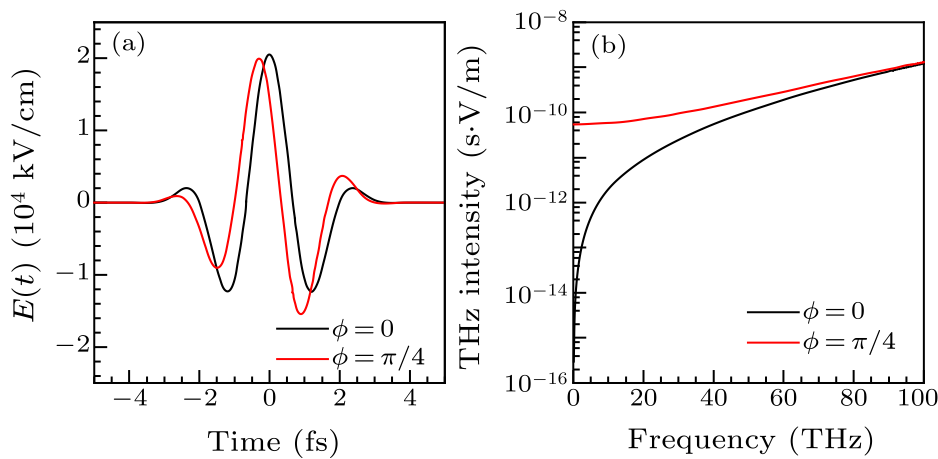
Fig. 1. (a) Waveforms of three-cycle 800-nm laser fields for CEPs of $\phi=0$ and $\pi/4$, respectively. (b) The corresponding THz spectra generated from graphene.
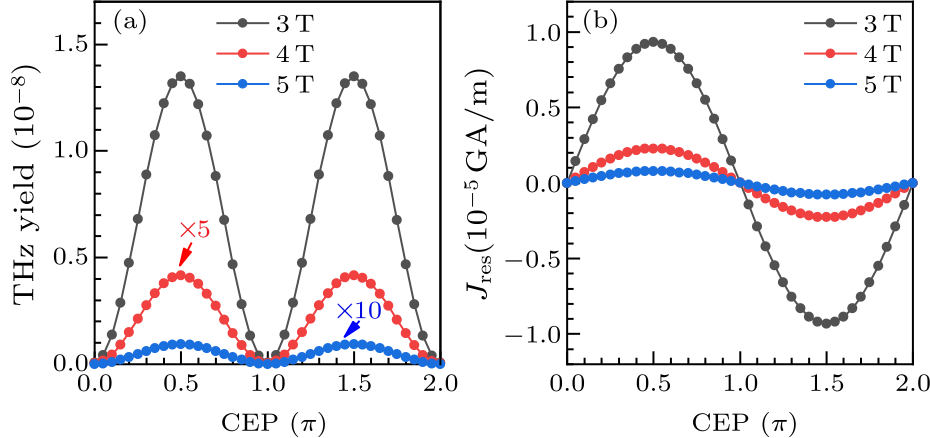
Fig. 2. Dependence of (a) low-frequency THz yield (0.1–10 THz) and (b) residual current on the CEP and width of the driving laser pulse.
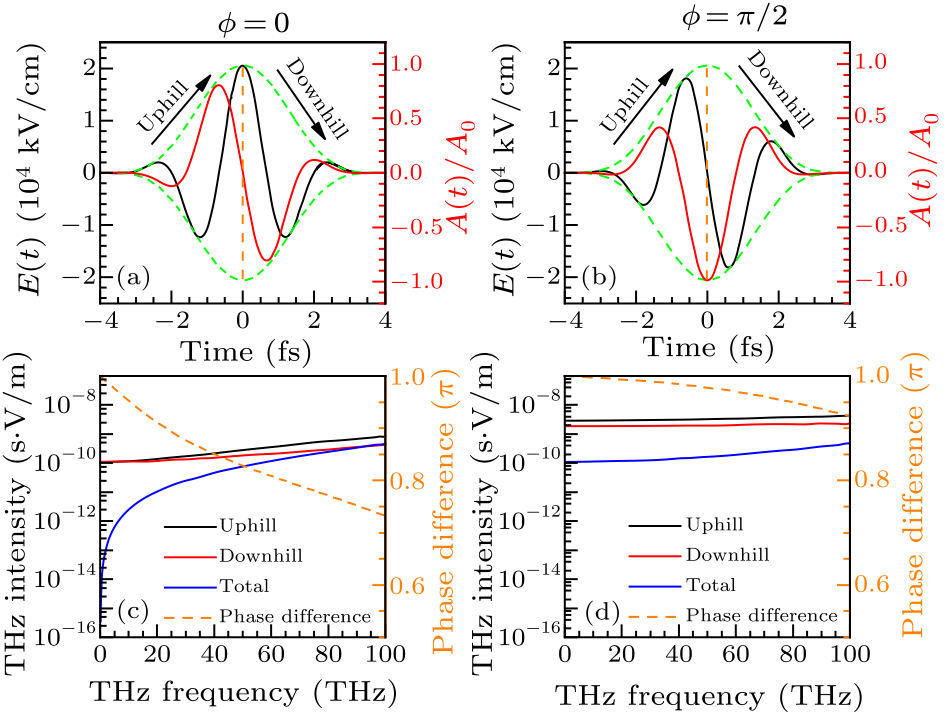
Fig. 3. Comparison of laser waveforms and generated THz radiations for $\phi=0$ [(a), (c)] and $0.5\pi$ [(b), (d)], respectively.
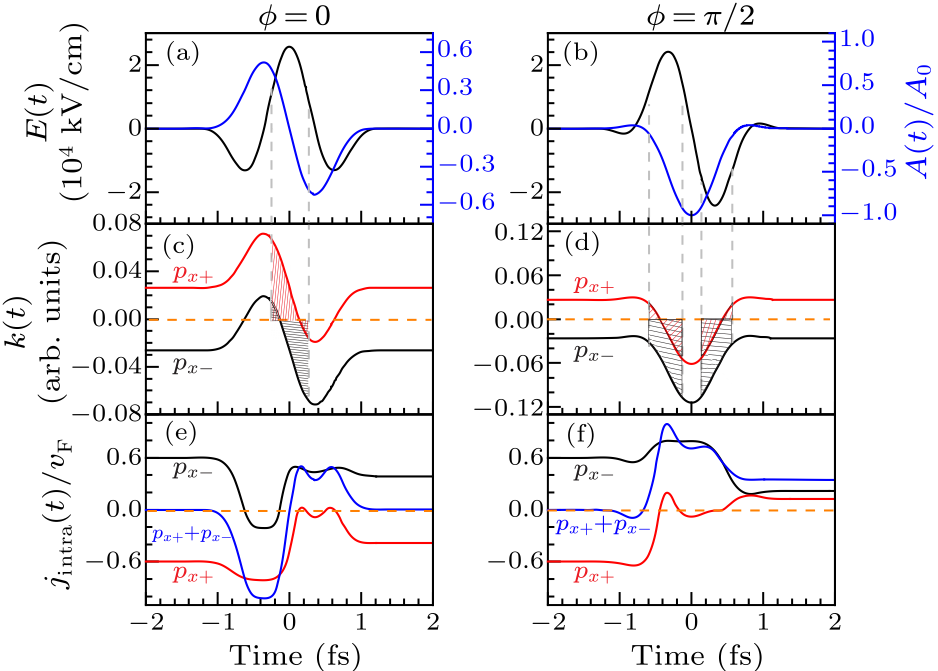
Fig. 4. Electron trajectory $k(t)$ [(c), (d)], and intra-band current $j_{_{\scriptstyle \rm{Intra}}}(t)$ [(e), (f)], induced by electrons with initial positive and negative wave numbers ($p_{x+}$ and $p_{x-}$) in a laser field with CEP values of $\phi=0$ (a) and $\phi=0.5\pi$ (b), respectively.
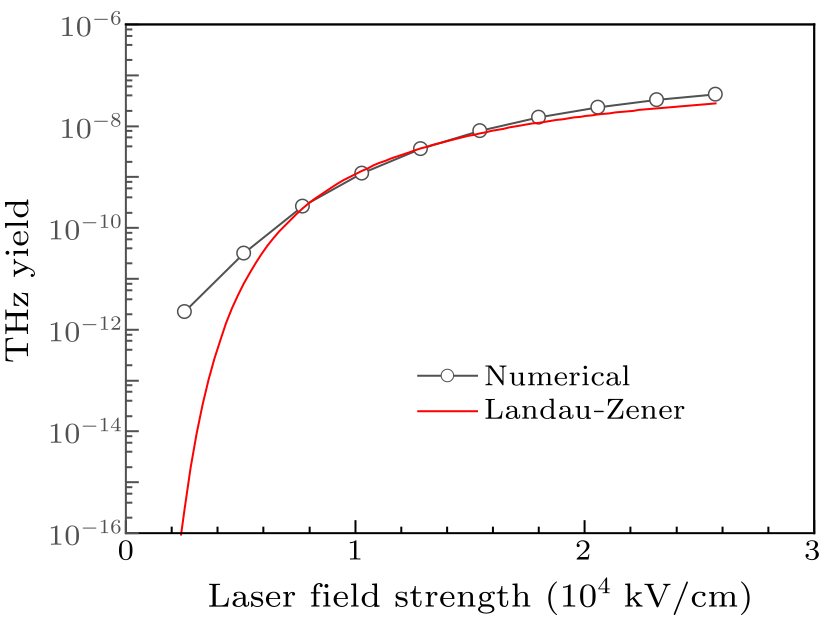
Fig. 5. THz yield between 0.1 THz and 10 THz as a function of strength for laser pulses of 800-nm wavelength and three-cycle duration (circle). The solid line depicts the tunneling rate, calculated based on the Landau–Zener formula.
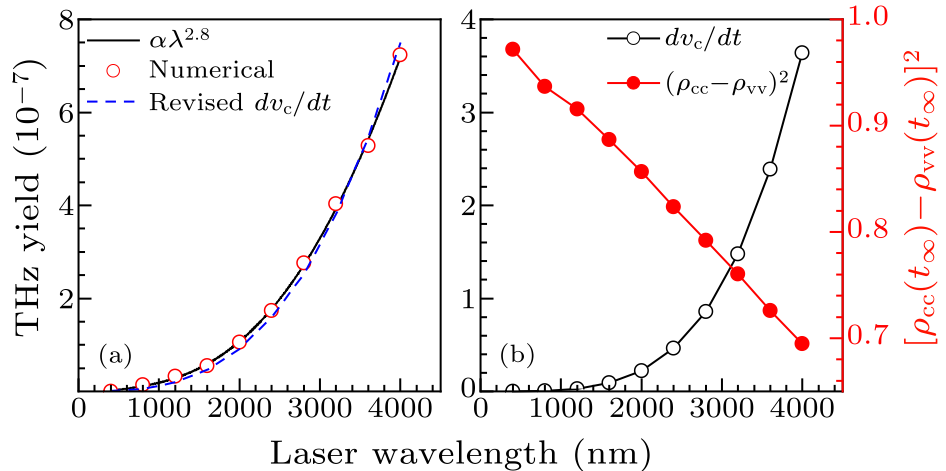
Fig. 6. (a) THz yield below 10 THz as a function of wavelength for laser pulses of three-cycle duration (circle). The solid line is a fitting curve, the dashed line depicts the THz radiation from $(\rho_{\rm cc}-\rho_{\rm vv})\frac{dv_{\rm c}(t)}{dt}$, which scales as $\lambda^{3}$. (b) The dependence of THz yield from $\frac{dv_{\rm c}(t)}{dt}$ and $(\rho_{\rm cc}-\rho_{\rm vv})^{2}$ on the laser wavelength.
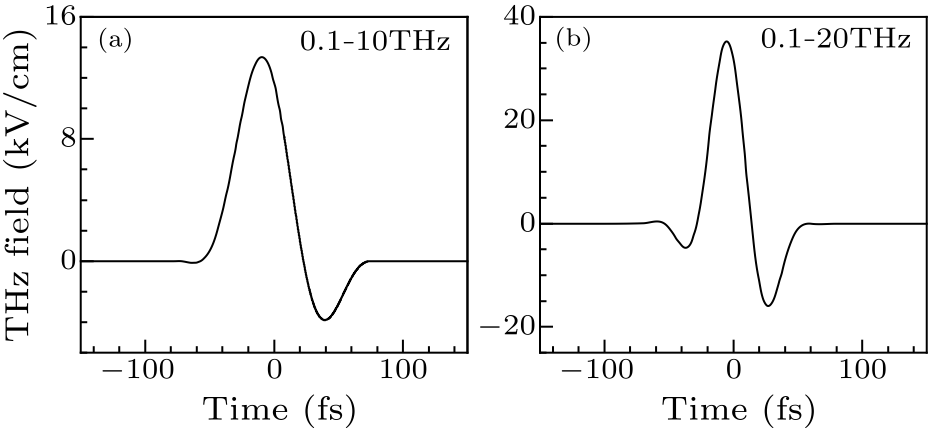
Fig. 7. Waveforms of THz fields with a frequency range of (a) 0.1–10 THz and (b) 0.1–20 THz, generated by a three-cycle 800-nm laser pulse
| [1] | Ferguson B and Zhang X C 2002 Nat. Mater. 1 26 | Materials for terahertz science and technology
| [2] | Dobroiu D, Otani C, and Kawase K 2006 Meas. Sci. Technol. 17 R161 | Terahertz-wave sources and imaging applications
| [3] | Hwang H Y, Fleischer S, Brandt N C, Perkins J B G, Liu M, Fan K, Sternbach A, Zhang X, Averitt R D, and Nelson K A 2015 J. Mod. Opt. 62 1447 | A review of non-linear terahertz spectroscopy with ultrashort tabletop-laser pulses
| [4] | Huang Y, Meng C, Wang X, Lü Z, Zhang D, Chen W, Zhao J, Yuan J, and Zhao Z 2015 Phys. Rev. Lett. 115 123002 | Joint Measurements of Terahertz Wave Generation and High-Harmonic Generation from Aligned Nitrogen Molecules Reveal Angle-Resolved Molecular Structures
| [5] | Zhou T, Zhang R, Yao C, Fu Z L, Shao S X, and Cao J C 2017 Chin. Phys. Lett. 34 084206 | Terahertz Three-Dimensional Imaging Based on Computed Tomography with Photonics-Based Noise Source
| [6] | Han X W, Hou L, Yang L, Wang Z Q, Zhao M M, and Shi W 2016 Chin. Phys. Lett. 33 120701 | Optical-Electrical Characteristics and Carrier Dynamics of Semi-Insulation GaAs by Terahertz Spectroscopic Technique
| [7] | Wang S, Zhu Z, Zhang Y, Yan T M, and Jiang Y 2021 Chin. Phys. Lett. 38 013401 | Rabi Oscillations and Coherence Dynamics in Terahertz Streaking-Assisted Photoelectron Spectrum
| [8] | Dey I, Jana K, Fedorov A D, Yu W V, Koulouklidis A D, Mondal A, Shaikh M, Sarkar D, Lad A D, Tzortzakis S, Couairon A, and Kumar G R 2017 Nat. Commun. 8 1184 | Highly efficient broadband terahertz generation from ultrashort laser filamentation in liquids
| [9] | Jin Q, Yiwen E, Williams K, Dai J, and Zhang X C 2017 Appl. Phys. Lett. 111 071103 | Observation of broadband terahertz wave generation from liquid water
| [10] | Balakin A V, Coutaz J L, Makarov V A, Kotelnikov I A, Peng Y, Solyankin P M, Zhu Y, and Shkurinov A P 2019 Photon. Res. 7 678 | Terahertz wave generation from liquid nitrogen
| [11] | Solyankin P M, Lakatosh B V, Krivokorytov M S, Tsygvintsev I P, Sinko A S, Kotelnikov I A, Makarov V A, Coutaz J L, Medvedev V V, and Shkurinov A P 2020 Phys. Rev. Appl. 14 034033 | Single Free-Falling Droplet of Liquid Metal as a Source of Directional Terahertz Radiation
| [12] | Cook D J and Hochstrasser R M 2000 Opt. Lett. 25 1210 | Intense terahertz pulses by four-wave rectification in air
| [13] | Kim K Y, Glownia J H, Taylor A J, and Rodriguez G 2007 Opt. Express 15 4577 | Terahertz emission from ultrafast ionizing air in symmetry-broken laser fields
| [14] | Zhang L, Wang G L, and Zhou X X 2016 J. Mod. Opt. 63 2159 | Optimized two- and three-colour laser pulses for the intense terahertz wave generation
| [15] | de González A M P, Babushkin I, Bergé L, Skupin S, Cabrera-Granado E, Köhler C, Morgner U, Husakou A, and Herrmann J 2015 Phys. Rev. Lett. 114 183901 | Boosting Terahertz Generation in Laser-Field Ionized Gases Using a Sawtooth Wave Shape
| [16] | Zhang X C, Shkurinov A, and Zhang Y 2017 Nat. Photon. 11 16 | Extreme terahertz science
| [17] | Ropagnol X, Khorasaninejad M, Raeiszadeh M, Safavi-Naeini S, Bouvier M, Côté C Y, Laramée A, Reid M, Gauthier M A, and Ozaki T 2016 Opt. Express 24 11299 | Intense THz Pulses with large ponderomotive potential generated from large aperture photoconductive antennas
| [18] | Huang S W, Granados E, Huang W R, Hong K H, Zapata L E, and Kärtner F X 2013 Opt. Lett. 38 796 | High conversion efficiency, high energy terahertz pulses by optical rectification in cryogenically cooled lithium niobate
| [19] | Fülöp J A, Palfalvi L, Klingebiel S, Almási G, Krausz F, Karsch S, and Hebling J 2012 Opt. Lett. 37 557 | Generation of sub-mJ terahertz pulses by optical rectification
| [20] | Hafez H A, Chai X, Ibrahim A, Mondal S, Férachou D, Ropagnol X, and Ozaki T 2016 J. Opt. 18 093004 | Intense terahertz radiation and their applications
| [21] | Higuchi T, Heide C, Ullmann K, Weber H B, and Hommelhoff P 2017 Nature 550 224 | Light-field-driven currents in graphene
| [22] | Bahk Y M, Ramakrishnan G, Choi J, Song H, Choi G, Kim Y H, Ahn K J, Kim D S, and Planken P C M 2014 ACS Nano 8 9089 | Plasmon Enhanced Terahertz Emission from Single Layer Graphene
| [23] | Maysonnave J, Huppert S, Wang F, Maero S, Berger C, de Heer W, Norris T B, De Vaulchier L A, Dhillon S, Tignon J, Ferreira R, and Mangeney J 2014 Nano Lett. 14 5797 | Terahertz Generation by Dynamical Photon Drag Effect in Graphene Excited by Femtosecond Optical Pulses
| [24] | Vampa G, Hammond T J, Thiré N, Schmidt B E, Légaré F, McDonald C R, Brabec T, and Corkum P B 2015 Nature 522 462 | Linking high harmonics from gases and solids
| [25] | Guan Z, Liu L, Wang G L, Zhao S F, Jiao Z H, and Zhou X X 2020 Chin. Phys. B 29 104206 | An improved method for the investigation of high-order harmonic generation from graphene
| [26] | Wang W M, Kawata S, Sheng Z M, Li Y T, and Zhang J 2011 Phys. Plasmas 18 073108 | Towards gigawatt terahertz emission by few-cycle laser pulses
| [27] | Gauthey F I, Garraway B M, and Knight P L 1997 Phys. Rev. A 56 3093 | High harmonic generation and periodic level crossings
| [28] | Wang W M, Kawata S, Sheng Z M, Li Y T, Zhang J, Chen L M, Qian L J, and Zhang J 2011 Opt. Lett. 36 2608 | Efficient terahertz emission by mid-infrared laser pulses from gas targets
| [29] | Wetzels A, Gürtler A, Muller H G, and Noordam L D 2001 Eur. Phys. J. D 14 157 | The dynamics of a THz Rydberg wavepacket
| [30] | LaRue J L, Katayama T, Lindenberg A, Fisher A S, Öström H, Nilsson A, and Ogasawara H 2015 Phys. Rev. Lett. 115 036103 | THz-Pulse-Induced Selective Catalytic CO Oxidation on Ru
| [31] | Cheng Q Y, Liu J S, Zhou X C, Song Y Z, and Meng Q T 2019 Europhys. Lett. 125 33001 | Field-free alignment dynamics of FCN molecule induced by a terahertz half-cycle pulse
| [32] | Gao Y, Drake T, Chen Z, and DeCamp M F 2008 Opt. Lett. 33 2776 | Half-cycle-pulse terahertz emission from an ultrafast laser plasma in a solid target
| [33] | Zhang L, Wang G L, Zhao S F, and Zhou X X 2017 Phys. Plasmas 24 023116 | Controlling of strong tunable THz emission with optimal incommensurate multi-color laser field
| [34] | Tailliez C, Stathopulos A, Skupin S, Buožius D, Babushkin I, Vaičaitis V, and Bergé L 2020 New J. Phys. 22 103038 | Terahertz pulse generation by two-color laser fields with circular polarization